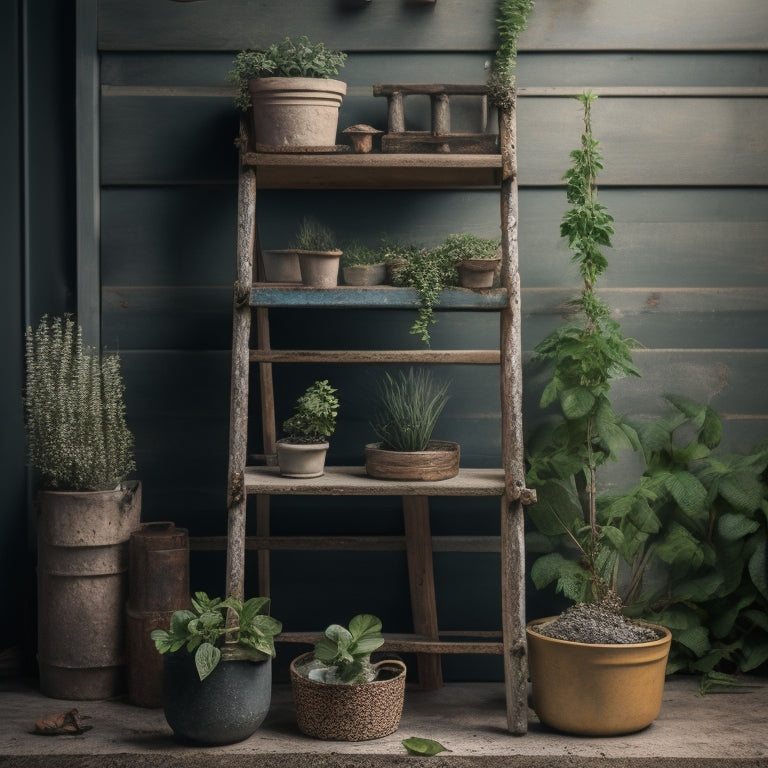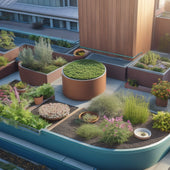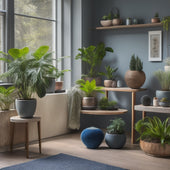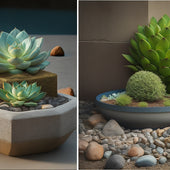
7 Thrifty Ways to Create Cinder Planters
Share
You can give old cinder blocks and bricks a new life by upcycling them into charming planters that enhance your garden's aesthetic appeal. Start by transforming cinder blocks into planters with good drainage and aeration, or use sturdy bricks to create unique planters that fit your design vision. You can also try DIY concrete molds or create a vertical garden using cinder blocks. Add a personal touch by painting and decorating your planters, and guarantee proper drainage with pebbles. For a small-space solution, create mini cinder planters that make perfect gifts. Now, learn how to get creative with these thrifty ideas and take your garden to the next level.
Key Takeaways
• Upcycle old cinder blocks into charming planters by thoroughly cleaning and customizing with paint or stain to fit desired color schemes.
• Select sturdy, porous bricks for transforming into planters, considering size, shape, and color to align with design vision and plant types.
• Prepare bricks by thoroughly cleaning, inspecting for damage, weatherproofing, and creating a rough surface for a solid foundation.
• Create DIY concrete planters using molds with a non-stick coating, experimenting with different concrete mix recipes for optimal results.
• Add aesthetic enhancements to planters by painting, decorating, or creating mini planters with small cinder blocks and decorative rocks or pebbles.
Upcycle Old Cinder Blocks
You can give old cinder blocks a new life by upcycling them into charming planters that add a touch of industrial chic to your garden or outdoor space. This DIY project is perfect for those who want to revamp their garden aesthetics without breaking the bank.
Start by collecting old cinder blocks and cleaning them thoroughly to remove any dirt or debris. You can then paint or stain them to match your desired color scheme. Once dry, fill the blocks with potting soil and add your chosen plants or flowers.
You can arrange them in a pattern or create a unique design to add visual interest. Upcycled cinder block planters aren't only eco-friendly but also provide good drainage and aeration for your plants. Plus, they can withstand harsh weather conditions, making them a durable option for your outdoor space.
With a little creativity, you can transform old cinder blocks into beautiful planters that elevate your garden's style and charm.
DIY Concrete Molds Method
As you start creating your own DIY concrete molds, you'll need to get the basics right.
You'll want to prepare your molds with the essentials, like a non-stick coating and a sturdy base, to guarantee your concrete planters turn out smooth and even.
From there, you can experiment with different concrete mix recipes and mold release techniques to achieve the perfect finish.
Mold Preparation Essentials
Essential preparation steps precede the creation of effective DIY concrete molds, which involve selecting and preparing a mold material, designing the mold's shape and size, and applying a release agent to ascertain a smooth, defect-free planter surface.
You'll need to choose from various mold types, such as silicone, plastic, or cardboard, each with its own advantages and limitations. For instance, silicone molds are flexible and easy to release, while plastic molds are more durable and can be reused multiple times. Regardless of the mold type, you'll need to maintain it properly to guarantee it lasts for multiple uses. Regularly clean and dry your mold, and apply a release agent before each use to prevent the concrete from sticking.
When designing your mold, consider the size and shape you want your planter to be. Make sure the mold is large enough to hold the concrete and any decorative elements you want to add.
You can also get creative with the mold's shape, using unusual shapes or combining multiple molds to create a unique design. By taking the time to properly prepare your mold, you'll be able to create a professional-looking planter that will add a touch of elegance to any room.
Concrete Mix Recipes
With your mold properly prepared, it's time to mix the concrete that will bring your planter design to life.
You'll need to create a mix that balances strength, durability, and workability. A good starting point is a standard concrete mix recipe: 1 part Portland cement, 2 parts sand, and 3 parts aggregate (such as gravel or crushed stone). However, you can adjust this ratio to achieve specific concrete properties. For example, adding more cement will increase strength, while adding more sand will improve workability.
When mixing, use a consistent technique to guarantee uniformity. Start by combining dry ingredients, then gradually add water while mixing with a shovel or trowel. Aim for a mix that's stiff but still pourable. Overmixing can lead to a weak, porous concrete, so stop mixing once the ingredients are just combined.
If you're new to working with concrete, it's a good idea to practice with a small batch to get a feel for the right consistency. By mastering these mixing techniques, you'll be able to create a strong, durable planter that will showcase your design skills.
Mold Release Techniques
How do you guarantee your concrete planter releases smoothly from the mold, without damaging the design or the mold itself? The secret lies in using the right mold release techniques.
When working with DIY concrete molds, it's crucial to apply a release agent to prevent the concrete from bonding with the mold. You can use a variety of release agents, such as cooking spray, petroleum jelly, or commercial mold release products. Apply a thin, even layer to the mold surface, making sure to cover every area that will come into contact with the concrete.
The type of mold you're using also plays a significant role in the release process. For example, silicone molds are naturally non-stick, making them ideal for concrete planters. However, if you're using a rigid mold, such as plastic or metal, you'll need to apply a release agent to guarantee a smooth release.
Transform Brick Into Planters
When transforming brick into planters, you'll need to choose the right brick for the job, considering factors like durability, color, and texture.
You'll also need to prepare your brick by cleaning and conditioning it to guarantee a strong bond with the cement.
Brick Selection Criteria
You'll want to choose bricks that are sturdy enough to hold the weight of the soil and plants, yet porous enough to allow for proper drainage and aeration. Cinder blocks, in particular, are great options due to their durability and ability to withstand harsh weather conditions.
When selecting bricks, consider the color options available to you. Do you want a natural, earthy tone or a bold, vibrant color to add a pop of personality to your planter? Brick color options can greatly impact the overall aesthetic of your cinder planter.
In addition to durability and color, think about the size and shape of the bricks. Will you need larger bricks to create a statement piece or smaller ones for a more delicate design?
Consider the space where your planter will sit and the type of plants you'll be using. By choosing the right bricks, you'll be able to create a sturdy, functional, and beautiful cinder planter that will thrive for years to come.
Take your time, and don't be afraid to get creative with your brick selection – it's an essential step in bringing your thrifty planter vision to life!
Brick Preparation Methods
Now that you've selected the perfect bricks for your cinder planter, it's time to transform them into functional planters. This step is vital, as it will determine the longevity and durability of your planter. Proper preparation is key to guaranteeing your bricks withstand the elements and support healthy plant growth.
To prepare your bricks, follow these essential steps:
-
Clean the bricks thoroughly to remove dirt, grime, or old mortar.
-
Inspect the bricks for any cracks or damage and set aside any that are beyond repair.
-
Apply a weatherproofing sealant to protect the bricks from moisture and extreme temperatures.
-
Use a wire brush to remove any loose debris and create a rough surface for better bonding.
-
If necessary, apply a layer of concrete bonding agent to guarantee a strong bond between the brick and mortar.
Cinder Block Vertical Garden
To create a visually striking and space-saving garden, stack cinder blocks to form a vertical garden, providing ample room for a variety of plants to thrive. This setup offers numerous cinder garden benefits, including maximizing space, improving drainage, and reducing soil erosion. By using vertical planting techniques, you can create a lush oasis even in small areas, such as balconies, patios, or rooftops.
To build your cinder block vertical garden, start by laying a level foundation of blocks. Then, stack additional blocks on top, leaving space between each layer for soil and plants. Make sure to alternate the blocks to create a sturdy structure. Once your framework is complete, fill in the gaps with a mix of soil, compost, and perlite. Plant your chosen flowers, herbs, or vegetables, and water thoroughly.
As you tend to your vertical garden, you'll appreciate the ease of maintenance and the opportunity to harvest your crops at eye level. With a little creativity and some cinder blocks, you can create a thriving garden that showcases your personal style and adds beauty to your outdoor space.
Paint and Decorate Planters
Transform your cinder planters into vibrant works of art by adding a pop of color and personality with paint and decorations that reflect your unique style. With a little creativity, you can turn plain cinder blocks into stunning planters that add a touch of elegance to your garden or indoor space.
To get started, choose from a wide range of color options to match your personal taste and style. You can opt for bold and bright hues, soft pastels, or metallic finishes to give your planters a modern twist.
Consider adding decorative finishes such as:
-
Glittering mosaics to add a touch of whimsy
-
Natural textures like burlap or twine for a rustic look
-
Metallic paint for a sleek, industrial vibe
-
Stencils or decals to add patterns or designs
-
Clear coat to protect your design and add a glossy finish
Add Drainage With Pebbles
By incorporating a layer of pebbles at the bottom of your cinder planter, you'll guarantee excess water drains freely, preventing waterlogged soil and root rot. This simple yet effective drainage solution is essential for maintaining healthy plants. Without it, you risk creating an environment that's conducive to fungal growth and root decay.
When adding pebbles, make sure to cover the entire surface of the planter's bottom. A layer about 1-2 inches thick should suffice. You can use small rocks, gravel, or even broken pottery pieces. The key is to create a porous surface that allows water to seep through, while keeping the soil and roots separate.
This clever trick won't only improve your planter's functionality but also enhance its aesthetics. The pebbles will add a decorative touch, creating a visually appealing contrast with the cinder material. Plus, you can choose pebbles that complement your planter's color scheme, further elevating its overall look.
Create Mini Cinder Planters
With a few simple materials and some creativity, you can create adorable mini cinder planters that are perfect for showcasing small plants or herbs on a windowsill or tabletop. These tiny planters are ideal for urban gardening and can add a touch of greenery to even the smallest of spaces.
To create your own mini cinder planters, you'll need:
- Small cinder blocks or concrete blocks
- Potting soil
- Small plants or herbs
- Decorative rocks or pebbles
- A hot glue gun (optional)
Simply cut the cinder blocks into smaller pieces, add a layer of potting soil and your chosen plant, and top with decorative rocks or pebbles.
If you want to get creative, use a hot glue gun to attach the blocks together and create a miniature garden.
These mini planters are perfect for adding a touch of greenery to your urban gardening space, and they make great gifts or decorations for any room.
Frequently Asked Questions
Can I Use Cinder Blocks With Cracks or Broken Edges?
You're wondering if you can use cinder blocks with cracks or broken edges. The answer is yes, but it depends on the extent of the damage.
If the cracks are minor, you can try repair techniques like sealing or patching to make them stable. However, if the edges are severely broken, it's best to choose another block to maintain aesthetic considerations.
After all, you want your planter to look its best, and broken edges can detract from its appeal.
How Long Do Cinder Planters Last Outdoors in Harsh Weather?
As the seasons ebb and flow, you wonder how long your outdoor creations will withstand the harsh weather.
When it comes to cinder planters, their lifespan depends on weather resistance and durability factors.
If you've sealed them properly, they can last for 5-7 years, but exposure to extreme temperatures, moisture, and sunlight can reduce their lifespan.
With proper care, you can extend their life, but be prepared to replace them eventually.
Are Cinder Planters Suitable for Vegetables and Herbs?
You're wondering if cinder planters are suitable for growing veggies and herbs. The answer is yes!
Cinder planters can provide excellent drainage, which promotes healthy root systems and prevents waterlogged soil. This is especially important for herbs, as they're prone to root rot.
For veggies, cinder planters can help prevent fungal diseases that thrive in moist environments.
With proper care, you'll enjoy robust herb growth and healthy vegetable harvests. Just be sure to add organic matter to the soil to maintain its fertility.
Can I Move Cinder Planters Around the Garden Easily?
Did you know that 70% of gardeners move their planters at least once a season? You're likely among them!
When it comes to moving cinder planters around the garden easily, you'll want to take into account mobility factors like weight, size, and handle design.
Mastering lifting techniques, such as the 'hug and lift' method, will also make a big difference.
With a little planning and practice, you'll be effortlessly rearranging your planters to maximize sunlight and optimize growth.
Do Cinder Planters Attract Pests Like Ants or Rodents?
When using planters, you're probably wondering if they'll attract unwanted pests like ants or rodents.
The good news is that you can take steps to prevent this. Choose a well-draining soil that doesn't retain moisture, making it less appealing to pests.
Additionally, consider adding pest-repellent plants like mint or basil to your planter.
Conclusion
You've finally made it to the end of this article, and congratulations, you're now a certified expert in creating cinder planters on a shoestring budget!
Pat yourself on the back, because you've managed to upcycle, DIY, transform, and decorate your way to a garden that's both functional and aesthetically pleasing.
Go ahead, flaunt your new planters to your friends and family, and watch as they green with envy (pun intended).
Related Posts
-

3 Best Roof Garden Drainage Solutions for Planters
When designing your roof garden, you'll want to implement a planter drainage system that guarantees water flows freel...
-

3 Best Roof Garden Drainage Solutions for Planters
When designing your roof garden, you'll want to implement a planter drainage system that guarantees water flows freel...
-

3 Best Roof Garden Drainage Solutions for Planters
When designing your roof garden, you'll want to implement a planter drainage system that guarantees water flows freel...
-

3 Best Roof Garden Drainage Solutions for Planters
When designing your roof garden, you'll want to implement a planter drainage system that guarantees water flows freel...
-

3 Best Roof Garden Drainage Solutions for Planters
When designing your roof garden, you'll want to implement a planter drainage system that guarantees water flows freel...
-

3 Best Roof Garden Drainage Solutions for Planters
When designing your roof garden, you'll want to implement a planter drainage system that guarantees water flows freel...
-

3 Best Roof Garden Drainage Solutions for Planters
When designing your roof garden, you'll want to implement a planter drainage system that guarantees water flows freel...
-

3 Best Roof Garden Drainage Solutions for Planters
When designing your roof garden, you'll want to implement a planter drainage system that guarantees water flows freel...
-

3 Best Roof Garden Drainage Solutions for Planters
When designing your roof garden, you'll want to implement a planter drainage system that guarantees water flows freel...
-

3 Best Roof Garden Drainage Solutions for Planters
When designing your roof garden, you'll want to implement a planter drainage system that guarantees water flows freel...
-

3 Best Roof Garden Drainage Solutions for Planters
When designing your roof garden, you'll want to implement a planter drainage system that guarantees water flows freel...
-

3 Best Roof Garden Drainage Solutions for Planters
When designing your roof garden, you'll want to implement a planter drainage system that guarantees water flows freel...
-

3 Best Roof Garden Drainage Solutions for Planters
When designing your roof garden, you'll want to implement a planter drainage system that guarantees water flows freel...
-

7 Best Concrete Planter Ideas for Indoor Gardens
You're looking for a stylish and low-maintenance way to bring some greenery into your home, and concrete planters off...
-

7 Best Concrete Planter Ideas for Indoor Gardens
You're looking for a stylish and low-maintenance way to bring some greenery into your home, and concrete planters off...
-

7 Best Concrete Planter Ideas for Indoor Gardens
You're looking for a stylish and low-maintenance way to bring some greenery into your home, and concrete planters off...
-

7 Best Concrete Planter Ideas for Indoor Gardens
You're looking for a stylish and low-maintenance way to bring some greenery into your home, and concrete planters off...
-

7 Best Concrete Planter Ideas for Indoor Gardens
You're looking for a stylish and low-maintenance way to bring some greenery into your home, and concrete planters off...
-

7 Best Concrete Planter Ideas for Indoor Gardens
You're looking for a stylish and low-maintenance way to bring some greenery into your home, and concrete planters off...
-

7 Best Concrete Planter Ideas for Indoor Gardens
You're looking for a stylish and low-maintenance way to bring some greenery into your home, and concrete planters off...
-

7 Best Concrete Planter Ideas for Indoor Gardens
You're looking for a stylish and low-maintenance way to bring some greenery into your home, and concrete planters off...
-

7 Best Concrete Planter Ideas for Indoor Gardens
You're looking for a stylish and low-maintenance way to bring some greenery into your home, and concrete planters off...
-

7 Best Concrete Planter Ideas for Indoor Gardens
You're looking for a stylish and low-maintenance way to bring some greenery into your home, and concrete planters off...
-

7 Best Concrete Planter Ideas for Indoor Gardens
You're looking for a stylish and low-maintenance way to bring some greenery into your home, and concrete planters off...
-

7 Best Concrete Planter Ideas for Indoor Gardens
You're looking for a stylish and low-maintenance way to bring some greenery into your home, and concrete planters off...
-

7 Best Concrete Planter Ideas for Indoor Gardens
You're looking for a stylish and low-maintenance way to bring some greenery into your home, and concrete planters off...
-

7 Best Concrete Planter Ideas for Indoor Gardens
You're looking for a stylish and low-maintenance way to bring some greenery into your home, and concrete planters off...
-

7 Best Concrete Planter Ideas for Indoor Gardens
You're looking for a stylish and low-maintenance way to bring some greenery into your home, and concrete planters off...
-

7 Best Concrete Planter Ideas for Indoor Gardens
You're looking for a stylish and low-maintenance way to bring some greenery into your home, and concrete planters off...
-

7 Best Concrete Planter Ideas for Indoor Gardens
You're looking for a stylish and low-maintenance way to bring some greenery into your home, and concrete planters off...
-

7 Best Concrete Planter Ideas for Indoor Gardens
You're looking for a stylish and low-maintenance way to bring some greenery into your home, and concrete planters off...
-

7 Best Concrete Planter Ideas for Indoor Gardens
You're looking for a stylish and low-maintenance way to bring some greenery into your home, and concrete planters off...
-

7 Best Concrete Planter Ideas for Indoor Gardens
You're looking for a stylish and low-maintenance way to bring some greenery into your home, and concrete planters off...
-

7 Best Concrete Planter Ideas for Indoor Gardens
You're looking for a stylish and low-maintenance way to bring some greenery into your home, and concrete planters off...
-

7 Best Concrete Planter Ideas for Indoor Gardens
You're looking for a stylish and low-maintenance way to bring some greenery into your home, and concrete planters off...
-

7 Best Concrete Planter Ideas for Indoor Gardens
You're looking for a stylish and low-maintenance way to bring some greenery into your home, and concrete planters off...
-

Succulent-Friendly Drainage Solutions for Block Planters
You can create a succulent-friendly drainage system in your cinder block planters by drilling holes in the bottom of ...
-

Succulent-Friendly Drainage Solutions for Block Planters
You can create a succulent-friendly drainage system in your cinder block planters by drilling holes in the bottom of ...
-

Succulent-Friendly Drainage Solutions for Block Planters
You can create a succulent-friendly drainage system in your cinder block planters by drilling holes in the bottom of ...
-

Succulent-Friendly Drainage Solutions for Block Planters
You can create a succulent-friendly drainage system in your cinder block planters by drilling holes in the bottom of ...
-

Succulent-Friendly Drainage Solutions for Block Planters
You can create a succulent-friendly drainage system in your cinder block planters by drilling holes in the bottom of ...
-

Succulent-Friendly Drainage Solutions for Block Planters
You can create a succulent-friendly drainage system in your cinder block planters by drilling holes in the bottom of ...
-

Succulent-Friendly Drainage Solutions for Block Planters
You can create a succulent-friendly drainage system in your cinder block planters by drilling holes in the bottom of ...
-

Succulent-Friendly Drainage Solutions for Block Planters
You can create a succulent-friendly drainage system in your cinder block planters by drilling holes in the bottom of ...
-

Succulent-Friendly Drainage Solutions for Block Planters
You can create a succulent-friendly drainage system in your cinder block planters by drilling holes in the bottom of ...
-

Succulent-Friendly Drainage Solutions for Block Planters
You can create a succulent-friendly drainage system in your cinder block planters by drilling holes in the bottom of ...
-

Succulent-Friendly Drainage Solutions for Block Planters
You can create a succulent-friendly drainage system in your cinder block planters by drilling holes in the bottom of ...
-

Succulent-Friendly Drainage Solutions for Block Planters
You can create a succulent-friendly drainage system in your cinder block planters by drilling holes in the bottom of ...
-

Succulent-Friendly Drainage Solutions for Block Planters
You can create a succulent-friendly drainage system in your cinder block planters by drilling holes in the bottom of ...
-

Succulent-Friendly Drainage Solutions for Block Planters
You can create a succulent-friendly drainage system in your cinder block planters by drilling holes in the bottom of ...
-

Succulent-Friendly Drainage Solutions for Block Planters
You can create a succulent-friendly drainage system in your cinder block planters by drilling holes in the bottom of ...


